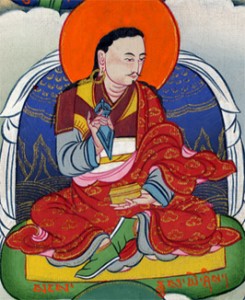
The masters known to us as the twenty-five principal disciples of Guru Rinpoche were the participants of what is called the first assembly [1]—the event at which Guru Rinpoche first gathered disciples together in Tibet and taught them vajrayana. The twenty-five who received empowerment on that day in the Caves of Chimphu each threw a golden flower that landed on one or another of the nine areas (or realms) of the mandala. Guru Rinpoche then gave each of them a particular dispensation (a practice) corresponding to the area of the mandala on which their flower landed, and it was that particular dispensation that each of them pursued in practice. Some of them, for example, practiced Manjushri Yamantaka; others practiced Hayagriva, Perfect Heruka, Amrita Qualities, or Vajrakilaya, and so on. This was all based upon the auspicious coincidence of where their flower landed.
One of the twenty-five disciples was the prime minister under King Trisong Detsen, who as a layperson was known as Dorje Tritsun. Today he is better known by his dharma name, Sangye Yeshe. Because he came from Nup clan, he was called the Great Nup Sangye Yeshe, or Nupchen Sangye Yeshe. His flower landed on the southern quadrant of the mandala, and he was therefore given the dispensation of Manjushri Yamantaka. Through that practice he achieved perfect awakening.
Nupchen Sangye Yeshe was the first well-known Tibetan birth of Terchen Barway Dorje, and therefore of Bardor Tulku Rinpoche. We know this from several sources, one of which is the Supplication to Successive Lives that was composed by Terchen Barway Dorje at the request of the previous Garchen Rinpoche. [2]
There are extensive biographies of Nupchen Sangye Yeshe, including his autobiography. One account of his life can be found in The Hundred Tertons by Jamgön Kongtrül Lodrö Thaye. We know that Nupchen Sangye Yeshe lived for a very long time and his life extended into the reign of Langdarma, the king who was the grandson of Trisong Detsen and who attempted to destroy the Buddhadharma in Tibet. It was Nupchen Sangye Yeshe who prevented that destruction from being complete. At that time Nupchen was the leader of a large community of tantrikas (or lay tantric practitioners). In fact, he was given the title Leader of Thousands of Kila-Wielding Tantrikas. That activity was in violation of the king’s edict that all Buddhism be suppressed. He was, therefore, summoned into the presence of Langdarma, and Langdarma said to him, “Who are you?” Nupchen Sangye Yeshe replied, “I’m a Buddhist tantrika.” Langdarma ask, “Well, what power do you have?” In response, Nupchen Sangye Yeshe extended the forefinger of his right hand and produced, according to some, one scorpion, and according to others, nine iron scorpions, each of which had nine heads and eighteen pincers. Each of those scorpions was the size of a mid-size yak, and they shot around the room. The king was intimidated and said, “OK, I’ll leave you alone.” Nupchen Sangye Yeshe then said, “That’s not all,” and from his finger he shot lightning bolts that zoomed all around the palace, and so on. So the king said, “I’ll leave your lineage alone too.” At that point Nupchen was satisfied.
There is a saying that in the beginning the teachings were held by Nyang and in-between they were protected by Nup. This refers to the fact that Nupchen Sangye Yeshe was the one teacher who was powerful enough to intimidate the king into leaving the community of practitioners alone. This is why we have the oral teachings of the ancient tantras to this day.
[1] There were three such assemblies.
[2] The previous Garchen Rinpoche was a devoted disciple and also one of the principal dharma heirs of Terchen Barway Dorje. At one point he asked Terchen Barway Dorje to compose a supplication or prayer that would include a good selection of his previous lives. The prayer exists both in Tibetan and in English. The first of the Tibetan lives mentioned in it is Nupchen Sangye Yeshe.
